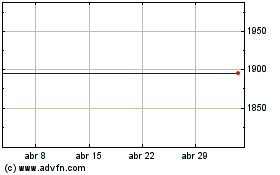Shell Profit Triples but Cash Flow Disappoints -- 2nd Update
01 Fevereiro 2018 - 8:00AM
Dow Jones News
By Sarah Kent
LONDON-- Royal Dutch Shell PLC more than tripled its profit in
2017 on a rebound in oil prices, but its closely watched cash-flow
figures fell short of expectations, alarming investors.
The British-Dutch oil giant said Thursday its 2017 profit on a
current cost-of-supplies basis--a number similar to the net income
that U.S. oil companies report--was $12.1 billion, up from $3.5
billion in 2016. Its earnings for the fourth quarter jumped to $3.1
billion from $1 billion a year earlier.
But its cash flow from operations fell 21% to $7.3 billion in
the fourth quarter from a year earlier. Shares in the company fell
2% just after opening in London, before recovering slightly to
trade down roughly 1% Thursday morning.
Investors have watched oil-company cash-flow numbers closely
since oil prices crashed in 2014, using them as a sign of a
company's financial toughness.
Bank analysts had expected higher cash-flow figures from Shell.
The amount of cash a company throws off from its operations is an
important indicator of its ability to finance spending plans and
dividends without having to take on debt.
Shell's mixed results mark the beginning of this earnings season
for big oil companies, which are expected to show healthier profit
margins during a year when oil prices recovered to their highest
levels since 2014. Exxon Mobil Corp. and Chevron Corp. are set to
announce their earnings on Friday, with BP PLC reporting on
Tuesday.
The oil industry has signaled growing financial confidence in
recent months as Brent crude, the international benchmark for oil
prices, has hovered close to $70 a barrel. The industry moved ahead
with 30 major new projects in 2017, more than double the number
from 2014-16 combined when oil prices were in the doldrums. Oil
companies are expected to launch the same number this year,
according to Wood Mackenzie, a Scottish energy consultancy.
The oil-market rally has come about as energy companies are
beginning to benefit from deep spending cuts and cost reductions
that have pushed down the price at which they make money from their
projects.
Until now, Shell had given investors some measure of confidence
in its ability to pay dividends. It had announced plans to scrap
its scrip dividend in November, a 2 1/2 -year-old program that had
allowed Shell to offer shareholders the option to take a portion of
their dividend in stock. The program was a popular choice among
bullish investors, but also raised concerns over dilution. The
company had also announced plans for $25 billion share-buyback
program.
The move to reward shareholders demonstrated the success of
yearslong efforts to restructure the business to cope with lower
oil prices. During the decline, energy firms that once struggled to
generate a profit at $100 a barrel have to cut costs to a level
where they could cover their spending and dividend commitments at a
price of $60 a barrel or lower.
The company said it generated nearly $28 billion in free cash
flow last year and reduced its net debt by $8 billion.
Write to Sarah Kent at sarah.kent@wsj.com
(END) Dow Jones Newswires
February 01, 2018 04:45 ET (09:45 GMT)
Copyright (c) 2018 Dow Jones & Company, Inc.
Shell (LSE:RDSA)
Gráfico Histórico do Ativo
De Mar 2025 até Abr 2025

Shell (LSE:RDSA)
Gráfico Histórico do Ativo
De Abr 2024 até Abr 2025
